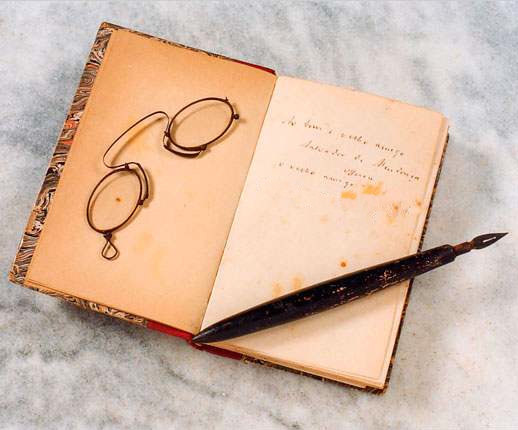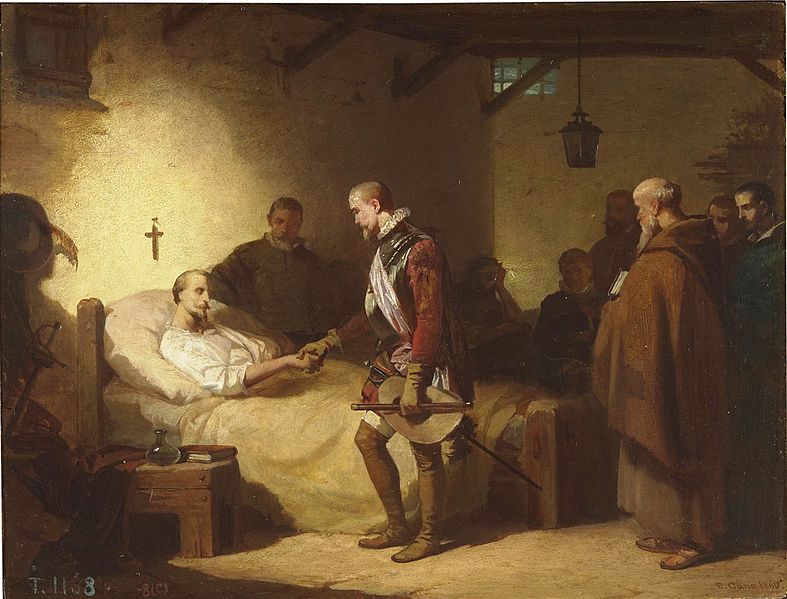By Ben Broussard *
Four hundred years ago, the famous Spanish author Miguel de Cervantes Saavedra passed away. He has since been heralded as one of the greatest writers in the Spanish language. However, word of his death had little impact on Castilian society. No public honors or national mourning marked the funeral of this Renaissance giant.
His most famous work, Don Quixote, became wildly popular during his life and more so after his death. Translations into French and English were soon followed by dozens of other languages. The misadventures of the title character Don Quixote and his sidekick Sancho Panza became popular in Europe and beyond. The delusional Don Quixote, intent on righting imagined wrongs and fighting chimerical foes, personifies idealism divorced from reality. Today he lends his name to the English word quixotic, meaning idealistic but impractical.
Intended or not, European society saw Don Quixote as a mockery of chivalric ideals, which were summarily abandoned in the century that followed. Considered the first modern novel, the influence of Don Quixote has been far reaching. Some questions arise as we examine the four centuries that have since passed: did Cervantes kill chivalry in publishing Don Quixote? And if so, was that his intention?
Using the Pen as a Sword
 Miguel de Cervantes came of age when the Renaissance was getting into full swing in his native Spain. King Philip II built his new capital at Madrid. His palace called “El Escorial” became the center of art, music and culture. Book printing allowed for the flourishing of popular works. Among these were medieval romances. Gone were the days of heroic epics such as The Song of Roland and The Story of My Cid. Romantic literature was all the rage at the time of Cervantes.
Miguel de Cervantes came of age when the Renaissance was getting into full swing in his native Spain. King Philip II built his new capital at Madrid. His palace called “El Escorial” became the center of art, music and culture. Book printing allowed for the flourishing of popular works. Among these were medieval romances. Gone were the days of heroic epics such as The Song of Roland and The Story of My Cid. Romantic literature was all the rage at the time of Cervantes.
Prof. Plinio Corrêa de Oliveira describes this time period in Revolution and Counter-Revolution:
Little by little, the seriousness and austerity of former times lost their value. The whole trend was toward gaiety, affability and festivity. Hearts began to shy away from the love of sacrifice, from true devotion to the Cross, and from the aspiration to sanctity and eternal life. The literature of love invaded all countries. Chivalry, formerly one of the highest expressions of Christian austerity, became amorous and sentimental.1
When Cervantes published Don Quixote, it was mocking exactly this sentimental spirit that had entered chivalry. Popular stories about romance and fantasy had already made a mockery of chivalry. The true stories about heroes of former times had been replaced by mawkish caricatures. Cervantes wrote to satirize this genre of romances, filled with clichés and nonsensical plots. In the prologue, the object of Don Quixote is clearly stated: “This book of yours aims at no more than destroying the authority and influence which books of chivalry have over the common people.”2
Early in Don Quixote, the character of the Canon of Toledo describes the flaws inherent in chivalric romances:
I have never seen a book of chivalry with a whole body for a plot, with all its limbs complete, so that the middle corresponds to the beginning, and the end to the beginning and middle; for they are generally made up of so many limbs that they seem intended rather to form a chimera or monster than a well-proportioned figure. What is more, their style is hard, their adventures are incredible, their love-affairs lewd, their compliments absurd, their battles long-winded, their speeches stupid, their travels preposterous and, lastly, they are devoid of all art and sense, and therefore deserve to be banished from a Christian commonwealth. 3
Should we need further proof, the last sentence of the second part drives home the author’s intention:
For my sole object has been to arouse men’s contempt for all fabulous and absurd stories of knight-errantry, whose credit this tale of my genuine Don Quixote has already shaken, and which will, without a doubt, soon tumble to the ground. 4
Chivalry’s Demise Greatly Exaggerated
Though most famous as an author, Cervantes held many professions during his life. As he repeatedly stated, his proudest moment came from his career as a soldier. In 1571, a young Cervantes joined the ranks of the soldiers of the Holy League, and sailed into the eastern Mediterranean to fight the Muslims. On the eve of the Battle of Lepanto, Cervantes became ill with fever and remained below decks as the fighting commenced. He could not resist taking part in the action, though. Rising and rushing up on deck, he bravely fought the Muslims attempting to board. Near the end of the battle, Cervantes was shot in the left hand, which was later amputated. He often remarked later, “All for the greater glory of the right.”

Miguel de Cervantes receiving the visit of Don Juan of Austria. Painting by Eduardo Cano at Prado Museum.
Cervantes himself always maintained the greatest reverence for idealism. His goal was to mock pseudo-chivalry. By his time, the damage to the chivalric ideal had already been done. Did Cervantes kill chivalry? No, since great ideals are hard to kill.
In fact, nineteenth century authors such as Sir Walter Scott and Lord Byron attempted to revive the tales of chivalry long since abandoned. Their attempts, however, resembled more the stories that Cervantes mocked than the true epics of chivalry. The influence of these neo-chivalric romances was far reaching. Scoffers such as Mark Twain went so far as to say that Sir Walter Scott’s Ivanhoe was the cause of the American Civil War. Few today would agree with this assertion. Nevertheless, books can have a profound impact on society. They can awaken ideals in the hearts of men, and they can also put them to sleep.

“All the while, modern man grasps at straws, pursuing selfish ends that lead away from real heroism.”
Which seems a more accurate description of what Cervantes did: chivalry did not die because of him. In reality, it fell asleep.
Awakening an Ideal
What will it take for true chivalry to awaken? Four centuries after Cervantes, most people can’t even define chivalry. True chivalry remains dormant. All the while, modern man grasps at straws, pursuing selfish ends that lead away from real heroism.
Leon Gautier, in his monumental work Chivalry, describes the origin of the knight’s raison d’etre:
The Church said to the barbarians of the ninth century: “Moderate your courage.” They did moderate it, and by degrees their savagery became prowess. “No knight without prowess,” said the old proverb. All other virtues ensue, hand in hand – loyalty, largesse, moderation, courtesy, and then honor, crowning all. The whole code of chivalry is contained in those six virtues. 5

Painting by Col. Charles Waterhouse of Col. John Ripley dangling above Cua Viet River as Angry North Vietnamese soldiers fire upon him.
We are now living in a neo-barbarian age. Today’s barbarians, however, are marked by immoderate cowardice rather than courage. For the crises plaguing modern society, men must embrace true chivalry once again. The dedication and self-sacrifice that marked past ages will also determine the outcome of our present age, whether for good or ill. As Cervantes showed, sentimentality must be abandoned. This must be the first step on the path to restoring a rule of honor, which as Gautier says, crowns all knightly virtue.
In Gautier’s great work in praise of chivalry, he dedicates his masterpiece to the contradictory figure of Miguel de Cervantes. Four hundred years after his death, they remain fitting words for remembering him:
I dedicate this work to the memory of Miguel Cervantes Saavedra, who laughed at chivalry in his books and was a true “chevalier” in his life. I dedicate it to the greatest of Spanish authors and to one of the most valiant soldiers of Spain — the author of Don Quixote — the wounded Knight of Lepanto!
Footnotes
- Plinio Corrêa de Oliveira, Revolution and Counter-Revolution (York, Penn.: The American Society for the Defense of Tradition, Family, and Property, 1993), Part I, Ch. 3-A, p. 14.
- Miguel de Cervantes Saavedra, and Samuel Putnam. Don Quixote. New York: Modern Library, 1998. p. 80.
- Ibid., p. 425.
- Ibid., p. 940.
- Leon Gautier, Chivalry. Translated by Henry Frith. p. 23.
*Published on TFP.org April 25, 2016











